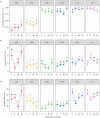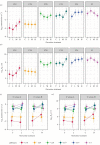Can pharmaceutical pollution alter the spread of infectious disease? A case study using fluoxetine
- PMID: 36744558
- PMCID: PMC9900710
- DOI: 10.1098/rstb.2022.0010
Can pharmaceutical pollution alter the spread of infectious disease? A case study using fluoxetine
Abstract
Human activity is changing global environments at an unprecedented rate, imposing new ecological and evolutionary ramifications on wildlife dynamics, including host-parasite interactions. Here we investigate how an emerging concern of modern human activity, pharmaceutical pollution, influences the spread of disease in a population, using the water flea Daphnia magna and the bacterial pathogen Pasteuria ramosa as a model system. We found that exposure to different concentrations of fluoxetine-a widely prescribed psychoactive drug and widespread contaminant of aquatic ecosystems-affected the severity of disease experienced by an individual in a non-monotonic manner. The direction and magnitude of any effect, however, varied with both the infection outcome measured and the genotype of the pathogen. By contrast, the characteristics of unexposed animals, and thus the growth and density of susceptible hosts, were robust to fluoxetine. Using our data to parameterize an epidemiological model, we show that fluoxetine is unlikely to lead to a net increase or decrease in the likelihood of an infectious disease outbreak, as measured by a pathogen's transmission rate or basic reproductive number. Instead, any given pathogen genotype may experience a twofold change in likely fitness, but often in opposing directions. Our study demonstrates that changes in pharmaceutical pollution give rise to complex genotype-by-environment interactions in its influence of disease dynamics, with repercussions on pathogen genetic diversity and evolution. This article is part of the theme issue 'Infectious disease ecology and evolution in a changing world'.
Keywords: R0; epidemic; global change; host–parasite interactions; parasite reproduction.
Figures



Similar articles
-
Pharmaceutical pollution alters the cost of bacterial infection and its relationship to pathogen load.Proc Biol Sci. 2024 Jan 10;291(2014):20231273. doi: 10.1098/rspb.2023.1273. Epub 2024 Jan 10. Proc Biol Sci. 2024. PMID: 38196353 Free PMC article.
-
Warmer temperatures limit the effects of antidepressant pollution on life-history traits.Proc Biol Sci. 2022 Feb 9;289(1968):20212701. doi: 10.1098/rspb.2021.2701. Epub 2022 Feb 9. Proc Biol Sci. 2022. PMID: 35135347 Free PMC article.
-
Host age modulates parasite infectivity, virulence and reproduction.J Anim Ecol. 2015 Jul;84(4):1018-28. doi: 10.1111/1365-2656.12352. Epub 2015 Mar 18. J Anim Ecol. 2015. PMID: 25661269
-
A Population Biology Perspective on the Stepwise Infection Process of the Bacterial Pathogen Pasteuria ramosa in Daphnia.Adv Parasitol. 2016;91:265-310. doi: 10.1016/bs.apar.2015.10.001. Epub 2015 Nov 26. Adv Parasitol. 2016. PMID: 27015951 Review.
-
The Minderoo-Monaco Commission on Plastics and Human Health.Ann Glob Health. 2023 Mar 21;89(1):23. doi: 10.5334/aogh.4056. eCollection 2023. Ann Glob Health. 2023. PMID: 36969097 Free PMC article. Review.
Cited by
-
Is there a sicker sex? Dose relationships modify male-female differences in infection prevalence.Proc Biol Sci. 2024 Jan 10;291(2014):20232575. doi: 10.1098/rspb.2023.2575. Epub 2024 Jan 10. Proc Biol Sci. 2024. PMID: 38196362 Free PMC article.
-
Infectious disease ecology and evolution in a changing world.Philos Trans R Soc Lond B Biol Sci. 2023 Mar 27;378(1873):20220002. doi: 10.1098/rstb.2022.0002. Epub 2023 Feb 6. Philos Trans R Soc Lond B Biol Sci. 2023. PMID: 36744560 Free PMC article. No abstract available.
-
Pharmaceutical pollution alters the cost of bacterial infection and its relationship to pathogen load.Proc Biol Sci. 2024 Jan 10;291(2014):20231273. doi: 10.1098/rspb.2023.1273. Epub 2024 Jan 10. Proc Biol Sci. 2024. PMID: 38196353 Free PMC article.
-
Insights in Pharmaceutical Pollution: The Prospective Role of eDNA Metabarcoding.Toxics. 2023 Nov 5;11(11):903. doi: 10.3390/toxics11110903. Toxics. 2023. PMID: 37999555 Free PMC article. Review.
References
Publication types
MeSH terms
Substances
Associated data
LinkOut - more resources
Full Text Sources
Other Literature Sources
Medical

